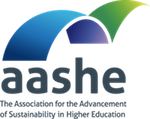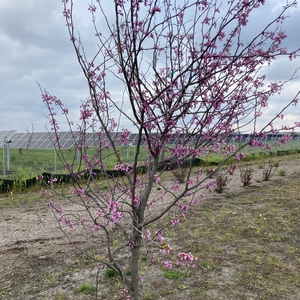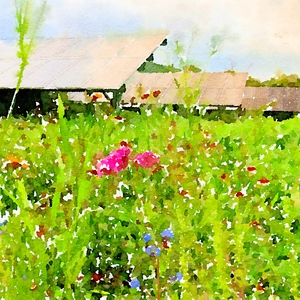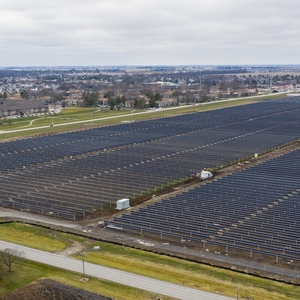UIUC Solar Farm 2.0: Ultra-Sustainable on-campus solar array
University of Illinois University Administration, University of Illinois, Urbana-Champaign
Project Overview
Referred to as “Solar Farm 2.0,” a new 54-acre, 12.32 megawatt (MWdc) utility-scale array is located on the University of Illinois Urbana-Champaign (UIUC) campus, north of Curtis Road, between First Street and Dunlap Avenue, near the Village of Savoy. Solar Farm 2.0 is producing approximately 20,000 megawatt-hours per year (MWh/year), nearly tripling the university’s existing on-site renewable energy generation. This project was coordinated by Facilities & Services (F&S), which is responsible for the utilities and energy infrastructure on campus. The Power Purchase Agreement (PPA) was completed by Prairieland Energy, Inc (PEI), which is a wholly-owned subsidiary of the University responsible for purchasing electricity through the MISO grid. The PPA gives the developer, Sol Systems, LLC, the responsibility to design, build, operate and maintain Solar Farm 2.0 for the duration of the 20-year agreement. All of the solar power and renewable energy certificates generated by Solar Farm 2.0 will be purchased and used on campus.
Background
The University of Illinois Urbana-Champaign signed the Second Nature Climate Leadership Commitments, pledging to be carbon neutral as soon as possible and no later than 2050 and to build resilience to climate change in our local community. The Illinois Climate Action Plan (iCAP) is the campus’ strategic plan to meet these commitments, and it is updated every five years, through broad public engagement under the guidance of the Institute for Sustainability, Energy, and Environment (iSEE).
The 2015 iCAP included a stretch goal of producing a minimum of 25,000 MWh/year of solar on campus property by fiscal year 2025. When the 2015 iCAP was written, the on-campus solar production level was only at 65 MWh/year, and Solar Farm 1.0 completed in 2015 was under construction and designed to produce about 7,000 MWh/year. Although the F&S team was concerned about our ability to reach this goal within university budget constraints, iSEE advocated strongly for it to be included as an objective in the iCAP. The Sustainability Council decided to include this objective, and gave F&S the responsibility to achieve the goal.
From 2015 to 2017, several methods for achieving the iCAP on-campus solar goal were evaluated by campus stakeholders, including additional rooftop solar and parking area canopies. In April 2017, the Energy Generation, Purchasing, and Distribution (eGen) Sustainability Working Advisory Team (SWATeam) at UIUC submitted recommendation eGen007 to "Start a project to expand the existing Solar farm, or install a new large scale solar installation in a new location." In November 2017, the iCAP Working Group (iWG) completed their assessment of the recommendation, stating "The iWG agrees that this is the most cost-effective method for meeting the iCAP objective of 25,000 MWh/year of on-campus solar generation by FY25. To meet that goal, the Solar Farm 2.0 project needs to begin soon, under F&S direction." In November of that same year, the Sustainability Council approved the concept of this new solar farm, and the site for the 54 acre array was selected and approved in the spring of 2018.
Goals
The primary goal was to produce at least 18,000 MWh/year from Solar Farm 2.0 on the University of Illinois campus electrical grid. Combined with the existing Solar Farm 1.0 production of approximately 7,000 MWh/year, this would meet the 2015 iCAP objective to produce at least 25,000 MWh/year from on-campus solar arrays. It will also contribute to the larger clean power objective in the iCAP to use at least 140,000 MWh/year of clean power by fiscal year 2025.
Additionally, the project was designed to be a multi-functional site, with pollinator supportive plantings throughout the area, and a public facing energy dashboard website to share production data for research and educational purposes. The pollinator supportive aspect included the goal to be officially recognized as “pollinator supportive” through the State of Illinois’s “Solar Site Pollinator Score Card.”
During implementation, Sol Systems partnered with South Bend, Indiana-based Inovateus Solar, which constructed the solar arrays. Inovateus brought an additional goal for the project to be Net-Zero Waste Construction.
Implementation
In the summer of 2018, after discussions with our neighbors in the Village of Savoy, the Chancellor’s Capital Review Committee approved the location, and a request for proposals was initiated through PEI. Different vendors from across the nation submitted proposals and various designs for this new solar farm, with nineteen submissions in total. By May of 2019, Sol Systems of Washington, D.C. was awarded the project.
Contracts were signed in December 2019, and Sol Systems worked with PEI and F&S staff to complete the design, campus electrical connection, and installation of the solar farm. National solar energy firm Sol Systems developed the farm with innovative features such as bifacial solar panels, single-axis trackers, pollinator habitat, and zero waste construction practices. This project is among the most technologically advanced and sustainable solar projects in the U.S. Through the firm’s development wing, Sol Customer Solutions, a joint venture between Sol Systems and Capital Dynamics, Capital Dynamics will serve as owners of the project with Sol Systems managing the asset throughout the 20-year term of the PPA.
This solar farm uses the latest technology to increase productivity of the site. The design features 31,122 bifacial solar panels that produce energy on both sides of the modules. Energy is captured on the back of the panels by collecting sunlight that is reflected off of the ground and adjacent modules. It also includes single-axis trackers that will allow panels to start the day facing east as the sun rises, and then rotate on an axis to track the sun throughout the day as the sun sets in the west. This way, the panels will receive direct sunlight throughout the entirety of the day. The bifacial panels and tracking system are estimated to increase production from the solar farm by 4.5% and 11.5%, respectively, for a total increase of approximately 3,100 MWh/year.
Sol Systems partnered with South Bend, Indiana-based Inovateus Solar, which constructed the solar arrays. Inovateus used reduced-waste construction practices that prevented as much as 45 tons of materials from reaching landfills. Specifically, Inovateus worked with F&S Waste Management to recycle nearly 94 percent of the project’s construction packaging, plastics, wood pallets, and other refuse. Throughout installation of the array, the Waste Transfer Station worked with the contractors to collect and process all the materials so everything that can be recycled was recycled. Recycled items included cardboard, scrap metal, wooden pallets, and other construction and demolition materials.
The planting of the project’s native pollinator habitat bookmarks the solar farm’s unique array of state-of-the-art technological and sustainable features. The site’s 54 acres will serve as a major demonstration and research location for pollinator-friendly solar arrays. The University of Illinois Solar Farm 2.0 project exceeded the required 85 minimum points established by the State of Illinois’ Pollinator Friendly Solar Site Act. With 134 points achieved on the pollinator scorecard, including the adjacent landscape buffer, the solar array officially “Provides Exceptional Habitat.” The custom seed mix designed by Natural Resource Services, with more than 21 different plant types that are native to the area, will make the land between and around the panels more resilient and create a natural habitat for a variety of local and migratory birds and beneficial insects. In total, the site will contain more than 6.5 million flowering plants and native grasses.
Timeline
- Request for Proposal Publication: February 2019
- Board of Trustees Approval: September 2019
- Contracts Signed: December 2019
- Start of Construction: July 2020
- Commercial Operation Date: January 2021
- Native Plant Seeding: May and June 2021
Financing
Prairieland Energy, Inc. (PEI), a wholly-owned subsidiary of the University, will buy the solar energy at a fixed rate of $45.99 per MWh for the duration of the 20 year term of the Power Purchase Agreement (PPA), and UIUC will receive the power and the associated renewable energy certificates (RECs), along with the right to claim the use of clean power. In addition to the long-term fixed rate, which hedges UIUC against future utility price volatility, the PPA allows the university to add solar production on-site with minimal upfront costs, providing an expected $300,000 in savings in the first year alone.
Solar Farm 2.0 is located on the South Farms of the main Urbana campus, and across the street from the Village of Savoy. Through discussions with Village leadership, the campus agreed to install a landscape buffer along the main roadway, adjacent to the solar farm site. The landscape buffer was funded separately from the Solar Farm, using funding from Carbon Credit Sales through the Second Nature Carbon Credit Purchasing Program (C2P2) with approval from the Executive Director of F&S and the Director of iSEE. The Student Sustainability Committee also contributed funding to the landscape buffer, for installation of over 200 native trees.
The C2P2 funding also supported preliminary outside legal counsel costs for the contracts.
Results
With the completion of the Solar Farm 2.0 project, the University of Illinois Urbana-Champaign will be the third largest producer of on-site clean power amongst U.S. universities, according to the U.S. Environmental Protection Agency’s Green Power Partnership website (accessed May 5, 2021). In total, with Solar Farms 1.0 and 2.0 and smaller solar production sites on campus, UIUC is now producing 27,000 MWh/year of on-site solar power, exceeding the original 2015 iCAP objective of 25,000 MWh/year – four years ahead of schedule.
Since the array was energized on January 29, 2021, the installation has produced over 4,000 megawatt hours (MWh). On May 1, Solar Farm 2.0 provided its largest output of 102 MWh in a single day, enough to offset the consumption of more than 8,000 gallons of gasoline.
Using the campus as a living learning laboratory for students and researchers is essential to the success of the university and a vital aspect of the campus sustainability goals described in the iCAP. During the installation phase, Sol Systems and Inovateus worked with students in the Institute for Sustainability, Energy, and Environment’s campuswide sustainability minor to assess the carbon footprint of Solar Farm 2.0 from sourcing to installation. Sol Systems will use the reports, produced by the student groups as part of their Sustainability, Energy and Environment Fellows Program capstone, to assess potential sustainability improvements to all future projects. Additionally, a team at Illinois State University (ISU) worked with F&S and Sol Systems to develop a virtual reality tour of Solar Farm 2.0 that will be available through smart phones later this year, using stereoscopic glasses. Researchers from the University of Illinois Chicago are also using this site to study the impacts of pollinator plantings under large-scale solar farms, and UIUC researchers are using details from this site’s design to propose an agrivoltaic research project in another area of the UIUC campus.
Lessons Learned
- Ultimately, the university expects to save approximately $300,000 per year because of this project.
- Higher education institutions should think outside the box and consider solar farms on available land via PPAs for financial benefits.
- By partnering with a professional solar developer, modern technology can be easily integrated, such as bi-facial panels and tracking systems.
- Include pollinator plantings under solar panels for multifunctional landscapes.
- Think about the neighbors, to build support from all levels – students, faculty, administration, AND the local community.



